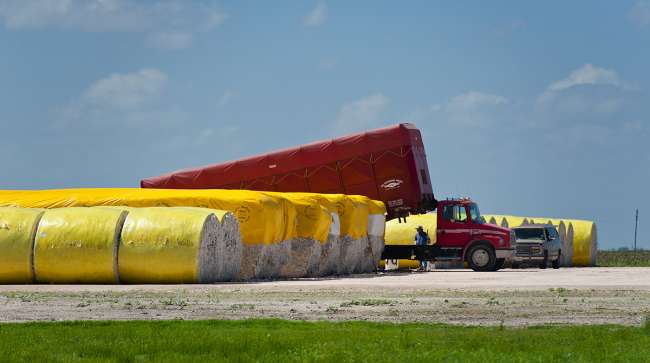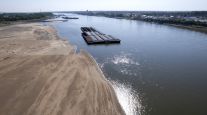Harvey Harms Cotton Output From Texas

Several hundred thousand bales of cotton likely were lost in Texas due to Hurricane Harvey, delivering a blow not only to those who grow and sell the state’s main agricultural crop but also to the motor carriers that haul it.
“The spot market for seasonal commodities is typically handled by smaller trucking companies — of which there are a couple hundred thousand — rather than larger companies, which focus on year-round commodities,” said Mark Montague, an analyst with load board provider DAT Solutions.
In terms of sheer numbers, cotton bales lost to Harvey probably will approach 400,000, John R.C. Robinson, a professor and economist specializing in cotton at Texas A&M AgriLife Extension Service, told Transport Topics.
RELATED: Carriers face congestion, rerouting after Harvey devastates Texas
Among the damaged or lost cotton includes some that still was on the stalk, meaning unharvested, as well as damaged field modules, which are collections of the cotton, he explained. In the most affected region, around Corpus Christi, the harvest had occurred but cotton still was sitting out in modules ready to be collected.
“They look like sticks of butter that have been melted, and no one knows to what extent the post-harvest effect will have,” he said.
What all of this damage will cost insurance companies is another looming question.
“It’s tough to quantify [the losses of cotton], but there are a lot more [insurance] claims” from farmers who have lost their harvest, said Brant Wilbourn, associate director of commodity and regulatory activity with the Texas Farm Bureau, based in Waco. “What I’ve heard consistently is a 250,000- o 500,000-bale loss in the South Texas crop market.”
RELATED: Trucks, planes and tankers putting Houston back in business after Hurricane Harvey
Robinson noted that the hardest-hit area is mainly centered on what’s called the upper coast region, just downcoast from Houston in Wharton, Jackson, Calhoun and Matagorda counties. The least-affected region yielded minor losses in the area around Taylor and Temple and along the Brazos River Bottoms, an area west of Bryan and College Station. Robinson said he can’t quantify those losses.
“The topic of cotton quality is multifaceted,” he said. “ But when nice, fluffy good-grade cotton gets rained on, it’s stained, and the color grades become poor. That contributes to a discounted price.”
Robinson added, “A lot of mature cotton got rain on it; almost all was ready to be harvested, so there will be widespread impacts, and even small impacts where the farmer will get dinged.”




